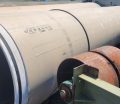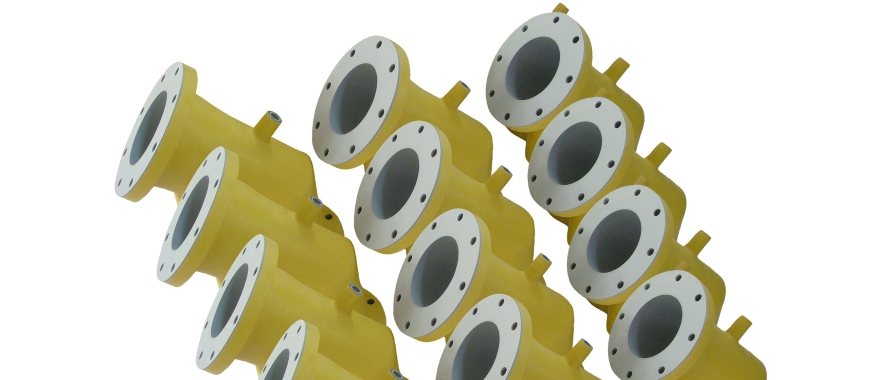
China CPVC FRP pipe is a composite piping solution that combines the chemical resistance of CPVC (Chlorinated Polyvinyl Chloride) with the mechanical strength of FRP (Fiberglass Reinforced Plastic). This combination results in a pipe that can withstand corrosive environments and high-pressure conditions, making it ideal for use in industries like chemical processing, wastewater treatment, and oil and gas. The CPVC inner layer offers excellent resistance to harsh chemicals, while the outer FRP layer provides structural integrity and durability. China’s expertise in manufacturing these pipes ensures a reliable and cost-effective solution for demanding industrial applications. China CPVC FRP pipes by GangLong Fiberglass offer durable, corrosion-resistant solutions, resisting acids, bases, chlorine, and high temperatures.
Comprehensive Guide of China CPVC FRP Pipe
China CPVC FRP pipe refers to a composite piping solution that combines chlorinated polyvinyl chloride (CPVC) with fiberglass-reinforced plastic (FRP). This combination results in a pipe that offers excellent chemical resistance, mechanical strength, and thermal stability. China CPVC FRP pipe is widely used in industries such as chemical processing, water treatment, oil and gas, and power generation due to its ability to withstand harsh operating conditions. GangLong Fiberglass specializes in manufacturing high-quality CPVC FRP pipes tailored to meet the demands of various applications.
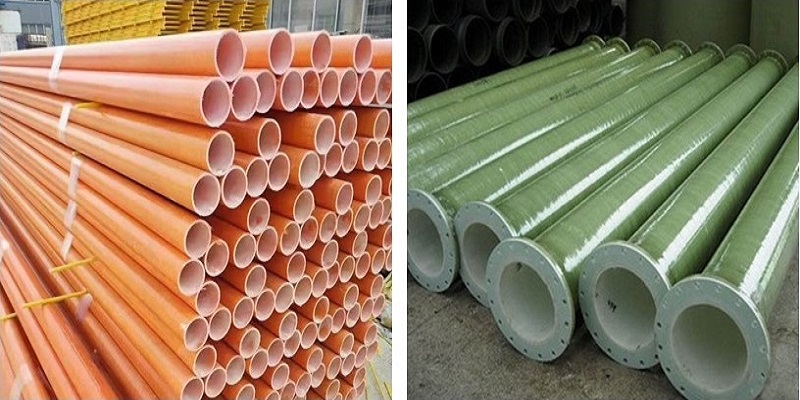
What is China CPVC FRP Pipe
China CPVC FRP pipe is a composite material that integrates the properties of CPVC and FRP to create a highly durable and corrosion-resistant piping solution. CPVC is a thermoplastic material known for its excellent chemical resistance, high-temperature performance, and low thermal conductivity. When combined with the strength and flexibility of fiberglass-reinforced plastic, the resulting CPVC FRP pipe exhibits enhanced performance characteristics that make it suitable for demanding industrial environments.
Composition: The inner layer of China CPVC FRP pipe is typically made of CPVC, which provides chemical resistance and a smooth inner surface for fluid transport. The outer layer consists of fiberglass-reinforced plastic, which offers mechanical strength, structural integrity, and protection against external factors such as impact and UV radiation. The composite structure ensures that the pipe can handle a wide range of chemicals, high temperatures, and mechanical stresses.
Manufacturing Process: The manufacturing process of China CPVC FRP pipe involves a combination of extrusion and filament winding techniques. The CPVC layer is extruded to form the inner liner, which is then reinforced with layers of fiberglass impregnated with resin using the filament winding process. This multi-layer construction provides a pipe with a high strength-to-weight ratio, excellent durability, and resistance to corrosion and environmental degradation.
The Key Benefits of China CPVC FRP Pipe
China CPVC FRP pipe offers several advantages that make it a preferred choice for various industrial applications. These benefits include superior chemical resistance, high-temperature performance, mechanical strength, and ease of installation.
Superior Chemical Resistance
Corrosion Resistance: One of the primary advantages of China CPVC FRP pipe is its superior resistance to corrosion. The CPVC inner layer provides excellent resistance to a wide range of corrosive chemicals, including acids, bases, salts, and organic solvents. This makes the pipe ideal for use in chemical processing plants, where the transport of aggressive chemicals is a common requirement. The FRP outer layer adds an additional layer of protection, enhancing the pipe’s durability and ensuring long-term performance in corrosive environments.
Chemical Compatibility: China CPVC FRP pipe is compatible with a broad spectrum of chemicals, making it suitable for diverse applications. The smooth inner surface of the CPVC liner minimizes the risk of chemical reactions with the transported fluids, reducing the potential for contamination and ensuring the purity of the transported medium.
High-Temperature Performance
Temperature Tolerance: China CPVC FRP pipe exhibits excellent thermal stability, allowing it to handle high-temperature fluids without compromising its structural integrity. The CPVC layer can withstand temperatures up to 200°F (93°C), making it suitable for applications involving hot fluids, steam, or thermal cycling. The FRP reinforcement provides additional thermal resistance, ensuring that the pipe maintains its performance even in fluctuating temperature conditions.
Thermal Insulation: The multi-layer construction of China CPVC FRP pipe provides thermal insulation properties that help maintain the temperature of the transported fluid. The low thermal conductivity of CPVC reduces heat loss or gain, making the pipe an energy-efficient choice for applications where temperature control is critical.
Mechanical Strength and Durability
High Strength-to-Weight Ratio: China CPVC FRP pipe offers a high strength-to-weight ratio, providing mechanical strength comparable to traditional piping materials like steel, while being significantly lighter. This lightweight nature simplifies handling, transportation, and installation, reducing labor costs and installation time. Despite its lightweight design, the pipe can withstand high internal pressures, mechanical loads, and external impacts, ensuring long-term reliability.
Impact and Abrasion Resistance: The fiberglass-reinforced plastic outer layer of the pipe provides excellent resistance to impact and abrasion, protecting the pipe from mechanical damage during installation and operation. This durability is particularly valuable in applications where the pipe is exposed to physical stresses, such as in underground installations, industrial settings, or areas with heavy traffic.
Ease of Installation and Maintenance
Simplified Installation: China CPVC FRP pipe is designed for easy installation, with options for various jointing methods, including FRP pipe adhesive bonding, mechanical joints, and flanged connections. The lightweight nature of the pipe reduces the need for heavy lifting equipment, making it easier to install in confined spaces or challenging environments. This ease of installation helps reduce project timelines and labor costs.
Low Maintenance: The corrosion-resistant properties of China CPVC FRP pipe result in low maintenance requirements. The pipe does not rust, corrode, or scale, reducing the need for frequent inspections, cleaning, or repairs. Its smooth inner surface minimizes fouling and buildup, ensuring consistent fluid flow and reducing the risk of clogging or blockages.
China CPVC FRP Pipe Fittings and Specifications
China CPVC FRP pipes are complemented by a wide range of fittings designed to facilitate complex piping layouts and ensure secure connections. These fittings are tailored to meet the specific needs of various industrial applications, providing versatility and reliability.
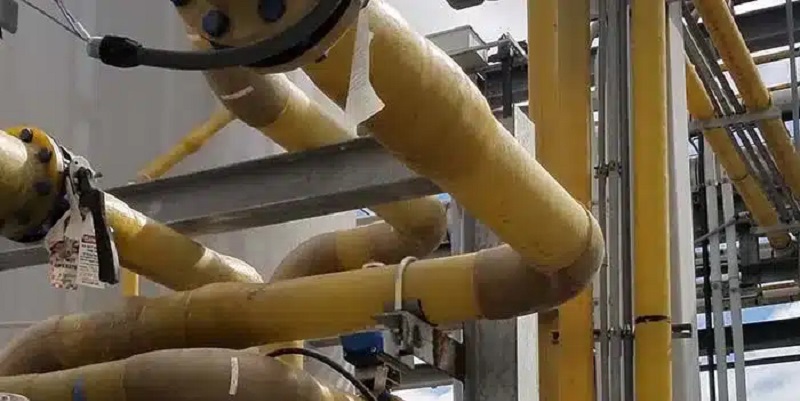
Types of Fittings
Flanged Elbows:
Flanged elbows are commonly used to change the direction of the piping system while maintaining a secure connection. These fittings are designed with flanged ends that can be bolted together, providing a leak-proof seal. Flanged elbows are available in various angles, including 45° and 90°, allowing for flexible installation in different piping configurations.
Full-Face Flanges:
Full-face flanges are used to connect CPVC FRP pipes to other piping components, such as valves, pumps, or equipment. These flanges provide a robust and leak-tight connection, ensuring the integrity of the piping system. Full-face flanges are available in different sizes and pressure ratings to accommodate various operational requirements.
Couplings:
Couplings are used to join two lengths of CPVC FRP pipe, providing a secure and flexible connection. They are typically designed with a bell-and-spigot configuration, allowing for easy assembly and disassembly. Couplings can be sealed using adhesives, gaskets, or mechanical restraints, depending on the application’s demands.
Reducers:
Reducers are used to connect pipes of different diameters, allowing for a smooth transition between sections of the piping system. This fitting is essential in applications where the flow rate or pressure needs to be adjusted.
Specifications
Size Range: China CPVC FRP pipes are available in a wide range of sizes to accommodate different flow requirements. Common sizes range from 25mm (1 inch) to 1200mm (48 inches) in diameter, with custom sizes available upon request.
Pressure Rating: The pressure rating of China CPVC FRP pipe depends on the pipe’s design, wall thickness, and the type of resin used in its construction. Standard pressure ratings range from 150 psi to 300 psi, making the pipe suitable for a variety of low-pressure and high-pressure applications.
Temperature Tolerance: China CPVC FRP pipe is designed to operate effectively at elevated temperatures. The CPVC layer provides thermal resistance, allowing the pipe to handle fluids with temperatures up to 200°F (93°C). This temperature tolerance makes the pipe suitable for hot water transport, steam lines, and other high-temperature applications.
Applications of China CPVC FRP Pipe
China CPVC FRP pipe is used in a wide range of industries due to its exceptional properties, including chemical resistance, mechanical strength, and thermal stability.
Chemical Processing
In chemical processing plants, China CPVC FRP pipe is used to transport aggressive chemicals, acids, and solvents. Its superior chemical resistance ensures that it can safely handle corrosive substances without degrading or leaching contaminants. The pipe’s smooth inner surface minimizes the risk of chemical reactions, preserving the purity of the transported fluids and ensuring the safety and efficiency of the processing system.
Water and Wastewater Treatment
China CPVC FRP pipe is widely used in water and wastewater treatment facilities for transporting potable water, sewage, and wastewater. The pipe’s corrosion-resistant properties make it ideal for use in environments where exposure to chemicals, chlorides, and other corrosive agents is common. Its smooth inner surface reduces the buildup of scale and biofilm, ensuring consistent flow and reducing maintenance requirements.
Oil and Gas
In the oil and gas industry, China CPVC FRP pipe is used for transporting hydrocarbons, produced water, and chemical additives. Its resistance to hydrocarbons, acids, and brine makes it suitable for use in harsh environments, including offshore platforms, refineries, and petrochemical plants. Additionally, GRP shelter are often employed alongside these pipes to protect critical equipment and infrastructure from harsh environmental conditions. The pipe’s high strength-to-weight ratio and thermal stability ensure reliable performance under high-pressure and high-temperature conditions.
The oil and gas industry presents some of the most challenging environments for piping systems, including exposure to hydrocarbons, high temperatures, and abrasive materials. China CPVC FRP pipe and China FRP sand pipe are both well-suited for use in this industry due to their superior resistance to hydrocarbons and aggressive chemicals. The CPVC lining protects the pipe from the corrosive effects of crude oil, natural gas, and other petroleum products, while the FRP reinforcement provides the necessary strength to handle high pressures and temperatures. Additionally, the lightweight nature of CPVC FRP pipes makes them easier to transport and install in remote or offshore locations, reducing installation costs and time. This combination of durability, chemical resistance, and ease of installation makes CPVC FRP pipes a preferred choice for oil and gas applications.
Applications of FRP Pipe Wet Layup in Industrial Rehabilitation
China CPVC FRP Pipe Manufacturing Process
China CPVC FRP pipe is a versatile and durable piping solution that integrates the chemical resistance of CPVC (Chlorinated Polyvinyl Chloride) with the mechanical strength of FRP (Fiberglass Reinforced Plastic). This dual-layer construction makes it ideal for use in demanding industrial environments, such as chemical processing, wastewater treatment, and oil and gas sectors. With advanced manufacturing processes, Chinese producers like GangLong Fiberglass have perfected the art of creating high-quality CPVC FRP pipes that offer superior performance, longevity, and cost-effectiveness. The combination of CPVC and FRP in these pipes provides enhanced resistance to corrosion, pressure, and temperature variations, making them suitable for a wide range of applications.
Manufacturing Process of CPVC FRP Pipe in China
The manufacturing process of China CPVC FRP pipe is a complex and precise procedure that involves combining CPVC with layers of fiberglass-reinforced plastic to produce a pipe that excels in both chemical resistance and mechanical strength. Chinese manufacturers employ advanced techniques and strict quality control measures to ensure that each pipe meets the required standards and performs reliably in its intended application.
CPVC Lining Preparation
The process begins with the preparation of the CPVC lining, which serves as the inner layer of the pipe. This lining is crucial as it provides the primary barrier against corrosive fluids and chemicals. The CPVC material is carefully selected based on its chemical compatibility with the fluids to be transported and its ability to withstand high temperatures. In some cases, additives are mixed with the CPVC to enhance its performance characteristics, such as increasing its resistance to UV radiation or improving its impact strength. The CPVC is then extruded or molded into the desired pipe shape, often utilizing FRP Pipe Mold to achieve precision and durability. This process ensures a smooth and uniform internal surface that minimizes friction and resists chemical attack.
Fiberglass Reinforcement Layer
Once the CPVC lining is prepared, the next step is to apply the fiberglass reinforcement layer. This layer is constructed using glass fibers that are impregnated with a thermosetting resin, such as polyester, vinyl ester, or epoxy. The choice of resin depends on the specific requirements of the application, including the level of chemical resistance, mechanical strength, and temperature tolerance needed. The fiberglass reinforcement process can involve various techniques, such as filament winding, fiberglass hand lay-up, or spray-up methods. In filament winding, continuous glass fibers are wound around the CPVC lining in a specific pattern to achieve the desired strength and structural integrity. This process allows for precise control over the thickness and orientation of the fiberglass layer, ensuring optimal performance of the finished pipe.
Curing and Hardening
After the fiberglass layer is applied, the pipe undergoes a curing process to harden the resin and bond the layers together. Curing is typically carried out using heat, UV light, or a chemical catalyst, depending on the type of resin used. During this process, the resin undergoes a chemical reaction that transforms it from a liquid or gel state into a solid, durable matrix that encapsulates the glass fibers and bonds them to the CPVC lining. The curing process is carefully controlled to ensure that the pipe achieves the desired mechanical properties, such as high tensile strength, impact resistance, and flexibility. Proper curing is essential to prevent defects like voids, cracks, or weak spots in the pipe structure, which could compromise its performance and longevity.
Quality Control and Inspection
Quality control is a critical aspect of the manufacturing process for China CPVC FRP pipe. Manufacturers like GangLong Fiberglass implement rigorous inspection and testing procedures at various stages of production to ensure that each pipe meets the required standards and specifications. Tests may include visual inspections for surface defects, dimensional checks to verify the pipe’s size and wall thickness, and mechanical tests to assess properties such as tensile strength, flexural strength, and impact resistance. Additionally, chemical resistance tests are conducted to ensure that the CPVC lining provides adequate protection against the intended fluids. By adhering to strict quality control measures, Chinese manufacturers ensure that their CPVC FRP pipes deliver reliable performance in the most demanding environments.
How Resin Types Impact FRP Pipe Tensile Strength
Specifications for Different Applications
China CPVC FRP pipe is manufactured in various sizes, pressure ratings, and temperature tolerances to meet the specific requirements of different applications. For example, a DN200 flanged elbow with a design pressure of 290 psi and a design temperature of 200°F is suitable for high-pressure chemical transport. Meanwhile, a DN50 full-face flange with a design pressure of 100 psi and a temperature rating of 170°F is ideal for lower-pressure applications like wastewater transport. By offering a range of specifications, manufacturers like GangLong Fiberglass provide customized solutions that ensure optimal performance and safety for each piping system.
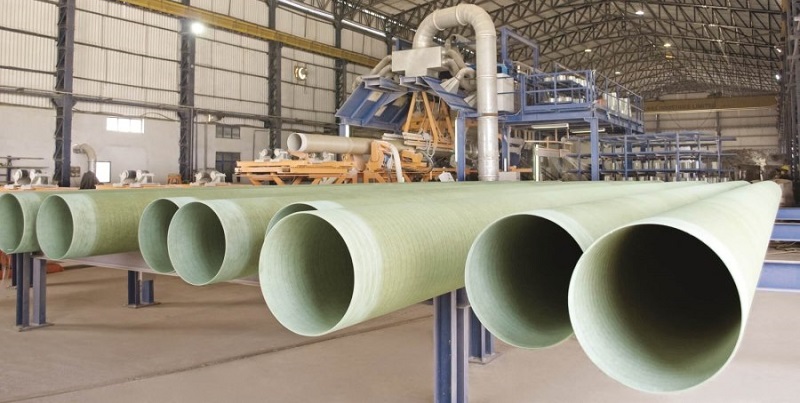
Superior Chemical Resistance
Compared to PVC and metal pipes, CPVC FRP pipes offer superior resistance to a wide range of chemicals. While PVC is resistant to many acids and bases, it can degrade when exposed to certain solvents, high temperatures, or UV radiation. Metal pipes, on the other hand, are susceptible to corrosion when exposed to aggressive chemicals, leading to leaks, pipe failure, and the need for costly maintenance. China CPVC FRP pipe provides a robust solution by combining the chemical resistance of CPVC with the mechanical strength of FRP. This combination allows the pipe to withstand aggressive chemicals, high temperatures, and UV exposure without degrading or losing its structural integrity.
Enhanced Mechanical Strength and Durability
FRP pipes are known for their mechanical strength and ability to withstand high pressures, but pure FRP pipes may lack the chemical resistance needed for certain applications. By incorporating a CPVC lining, China CPVC FRP pipe offers the best of both worlds: the chemical resistance of CPVC and the mechanical strength of FRP. This dual-layer construction enhances the pipe’s durability, allowing it to handle high pressures, mechanical stresses, and temperature variations without compromising performance. Additionally, CPVC FRP pipes are less prone to brittleness and cracking than other materials, ensuring a longer service life and reducing the need for repairs or replacements.
Top Challenges Contractors Face in Securing FRP Pipes Tenders
How to Choose a Reliable China CPVC FRP Pipe Manufacturer
When selecting a China CPVC FRP pipe manufacturer, consider the following factors:
Product Quality
Ensure the manufacturer adheres to international standards and uses high-grade CPVC and FRP materials to ensure durability and corrosion resistance.
Experience and Reputation
Look for a manufacturer with years of experience and positive feedback in producing CPVC FRP pipes, as this indicates reliability.
Customization and Variety
Choose a manufacturer offering a wide range of pipes, fittings, and accessories to meet diverse industrial needs.
Technical Support and Certification
Verify certifications like ISO, and ensure the company provides technical support for installation and maintenance.
Production Capacity and Delivery
Opt for a manufacturer with adequate production capacity to fulfill bulk orders and ensure timely delivery.
By evaluating these aspects, you can select a trustworthy manufacturer for durable and efficient China CPVC FRP pipes.
Advantages of GangLong Fiberglass as a China CPVC FRP Pipe Manufacturer
GangLong Fiberglass stands out as a reliable China CPVC FRP pipe manufacturer due to its commitment to product quality, innovation, and customer-centric service. With expertise in the R&D, design, and production of CPVC FRP pipes and related accessories, GangLong Fiberglass ensures high mechanical strength, exceptional corrosion resistance, and durability.
The company integrates traditional manufacturing values with modern techniques, offering a comprehensive range of customizable solutions to meet diverse industrial needs. GangLong Fiberglass emphasizes the development of advanced technologies and adopts efficient management practices, ensuring consistent product quality and reliable delivery.
Its experienced technical team provides ongoing support for installation and maintenance, ensuring customer satisfaction at every stage. By combining innovation, adaptability, and a focus on customer needs, GangLong Fiberglass has earned the trust of domestic and international clients, making it a preferred choice for CPVC FRP pipes and fittings.
FAQs about China Cpvc Frp Pipe
CPVC (Chlorinated Polyvinyl Chloride) and FRP (Fiberglass Reinforced Plastic) are both used in piping systems, but they differ significantly in terms of composition, properties, and applications. CPVC is a thermoplastic material made by chlorinating PVC resin, which enhances its temperature resistance and chemical durability. It is known for its ease of installation, resistance to corrosion, and ability to handle hot and cold fluids. CPVC is commonly used in residential plumbing, hot water distribution, and certain industrial applications where moderate chemical resistance is required.
FRP, on the other hand, is a composite material made by reinforcing a plastic matrix (usually polyester, vinyl ester, or epoxy resin) with glass fibers. This structure gives FRP pipes high strength, excellent chemical resistance, and the ability to withstand extreme conditions, including high pressures and corrosive environments. FRP pipes are often used in industries like chemical processing, wastewater treatment, and oil and gas, where harsh chemical exposure and mechanical stresses are common. Unlike CPVC, FRP pipes can be custom-engineered for specific applications, providing greater flexibility in terms of design, diameter, and wall thickness.
CPVC is still in use, but its popularity has declined in some areas due to certain limitations and the availability of more advanced piping materials like FRP. One reason CPVC is less favored in some industrial settings is its limited temperature and chemical resistance compared to materials like FRP. While CPVC can handle hot water and certain chemicals, it may degrade or become brittle when exposed to more aggressive chemicals, high temperatures, or UV radiation over time. This makes CPVC less suitable for environments with harsh chemical exposure or where long-term durability is critical.
In addition, CPVC can be prone to issues such as cracking and stress corrosion, especially if installed improperly or exposed to mechanical stress and vibration. These factors can lead to leaks and pipe failures, requiring frequent maintenance or replacement. For industries that demand high performance and reliability, materials like FRP offer a more robust solution. FRP pipes, with their superior strength, corrosion resistance, and customizability, are often chosen for applications where CPVC may fall short. However, CPVC remains a practical choice for certain residential and light industrial applications where its properties meet the system’s requirements.
FRP (Fiberglass Reinforced Plastic) pipe and PVC (Polyvinyl Chloride) pipe differ significantly in their composition, properties, and applications. PVC is a thermoplastic made from polyvinyl chloride, known for its lightweight, chemical resistance, and ease of installation. PVC pipes are commonly used in plumbing, irrigation, drainage, and low-pressure water transport due to their affordability and resistance to corrosion from water and certain chemicals. However, PVC has limitations in terms of temperature resistance and mechanical strength. It can become brittle in cold temperatures and may soften or deform when exposed to high temperatures.
FRP pipe, on the other hand, is a composite material consisting of a plastic matrix reinforced with glass fibers. This construction gives FRP pipes exceptional strength, durability, and resistance to a wide range of chemicals, including acids, alkalis, and solvents. FRP pipes can withstand high pressures and temperatures, making them suitable for demanding industrial applications such as chemical processing, wastewater treatment, and oil and gas transport. Unlike PVC, FRP pipes can be custom-engineered to meet specific requirements, including varying diameters, wall thicknesses, and reinforcement patterns. This flexibility, combined with their superior performance characteristics, makes FRP pipes the preferred choice for applications where PVC would not be sufficient.
CPVC (Chlorinated Polyvinyl Chloride) has some notable disadvantages despite its strength and versatility. One primary concern is its susceptibility to cracking under high physical stress or impact, especially in cold weather conditions. While CPVC FRP pipes (Fiber-Reinforced Plastic) enhance durability, CPVC itself remains more rigid and less flexible than alternatives like PEX, making it prone to stress failures over time. Additionally, CPVC pipes can deteriorate when exposed to certain chemicals, including strong solvents, which may limit their applications. Installation is another challenge—CPVC requires solvent welding, which demands skilled labor to ensure proper sealing and prevent leaks. Moreover, CPVC pipes have a lower tolerance for high-temperature spikes compared to metals, making them unsuitable for extremely high-temperature systems. While CPVC FRP pipes are robust and long-lasting, their brittleness in adverse conditions remains a notable limitation, particularly in heavy-duty or industrial environments.
Yes, CPVC is widely regarded as safe for drinking water applications. CPVC pipes, including CPVC FRP pipes, are specifically designed to meet stringent health and safety standards for potable water. They are non-toxic and resistant to leaching, ensuring water quality remains uncontaminated. CPVC does not corrode or scale like metal pipes, which means harmful contaminants such as rust or heavy metals cannot enter the water supply. Furthermore, CPVC has excellent resistance to biofilm formation, reducing the risk of bacterial growth within pipes. In China and globally, CPVC pipes are tested and approved by regulatory bodies, ensuring compliance with safety certifications like NSF/ANSI for drinking water systems. However, it is essential to install CPVC pipes correctly and avoid exposure to harsh chemicals that may compromise the material’s integrity. As a durable and hygienic solution, CPVC FRP pipes remain a safe and reliable choice for residential and commercial water supply systems.
The best plastic pipe for plumbing largely depends on the specific requirements of the project, but CPVC FRP pipes are among the top contenders for durability and performance. CPVC pipes are ideal for both hot and cold water systems due to their excellent heat resistance, chemical stability, and low maintenance. When reinforced with FRP (Fiber-Reinforced Plastic), they gain enhanced strength and durability, making them suitable for high-pressure and heavy-duty applications. CPVC FRP pipes are corrosion-resistant and long-lasting, outperforming traditional metal pipes in many environments. Other alternatives, like PEX pipes, offer flexibility but lack CPVC’s resistance to extreme temperatures and chemical exposure. In commercial and industrial plumbing systems, where reliability and lifespan are critical, CPVC FRP pipes are preferred for their superior performance. Their lightweight nature, ease of installation, and cost-effectiveness make them one of the best plastic pipe options for plumbing projects, particularly in demanding environments.

As the editor of GangLong Fiberglass, I have years of experience and in-depth research, focusing on cable tray products, fiberglass solutions, and grille systems. I incorporate years of industry insights and practical experience into every content, committed to promoting the progress of the industry. At GangLong Fiberglass, my commitment is reflected in every product, from innovative cable trays to durable fiberglass solutions and sturdy grille systems. As an authoritative voice in the industry, my goal is to provide valuable information to professionals and businesses and promote forward-looking solutions.


